Posted - 09/08/2016 Building a Sustainable and Resilient Haiti One Solar Panel at a Time

By 2016 ITP Grant Partner Elijah Romulus, 10Power
In the sunny Caribbean, Haiti shares the island of Hispaniola with the Dominican Republic. This country prides itself in being the 2nd country in the western hemisphere for gaining its independence. Unfortunately years and years later many of Haiti’s citizens find themselves dependent on unreliable electricity and insufficient ways of getting it. A country that relies on a lot of dirty technology can benefit from solar energy being close to the equator and can help the environment.
Haiti has a less than reliable grid that provides electricity to its people. In many cases there is no access to electrify in poor or rural areas. 66% of people in the country do not have access to electricity, one of the lowest electrification rates in the world. In the best cases the electricity available is extremely expensive. Solar power is a solution to Haiti’s energy problems, it can serve off the grid communities, or communities connected to the grid, in both cases providing a cheaper alternative. The introduction of a clean technology like solar systems can ease the issues of dirty technologies used currently whether it is coal, diesel.
Thanks to funding from Invoking The Pause and a supplemental campaign, social business 10Power and Haitian partner, DigitalKap were able to conduct community outreach and feasibility studies for a pay-as-you-go (PAYGO) program in some of the most energy impoverished communities in the country. 10Power and DigitalKap, a Haitian owned all-in-one solar provider, launched the Energy24 project, in the Haitian communes of Anse-a-Veau and Morency (outside of Les Cayes). Approximately 30,000 lives could be positively impacted within these villages. These towns are also central hubs in a network of villages in the South of Haiti, connecting communities.
Energy24’s PAYGO method allows consumers to lease an Energy24 system (10 kW, 100kW, and 150kW) and make mobile payments in order to activate the supply of power from the system. When the value added has been depleted, additional payments can be made to the system as desired to reactivate the power supply. The “Rent to Own†(R2O) method allows consumers to make small, manageable payments over a two-year period to eventually own the system outright. The flow of energy is continuous throughout the rental period (limited only by the capacity of the system, i.e. 100W). When the consumer has fully paid for the product they become the owner of the system. Fixed payments are made on a monthly basis during the rental period. The payment period is not to exceed two years but can be shorter. If a consumer chooses to make extra payments, they can own the system outright sooner. Extra payments will result in a lower overall cost to the consumer.
MORENCY
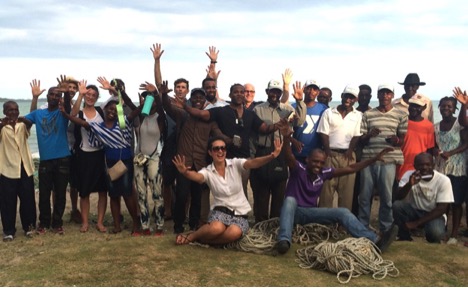 On August 9, 2016, we went to the small fishing village Morency to launch Energy24. The village is on the coast but in order to reach it we had to pass through a mountain with no finished roads. It was a time consuming to get to the village. The minibus we planned on going into the village with could not make the trip. Thanks to the help of the NGO Hope for Haiti, who 10Power had co-ordinated with to set up the community meeting, we were transported there by a pickup truck.
On August 9, 2016, we went to the small fishing village Morency to launch Energy24. The village is on the coast but in order to reach it we had to pass through a mountain with no finished roads. It was a time consuming to get to the village. The minibus we planned on going into the village with could not make the trip. Thanks to the help of the NGO Hope for Haiti, who 10Power had co-ordinated with to set up the community meeting, we were transported there by a pickup truck.When we arrived the children in the community all greeted up with freshly picked coconuts to hydrate in the heat in the humidity. The meeting was planned in advance, the community leader seemed to be a pastor and the meeting was held in a church. Hope for Haiti, who had done nonprofit work in the community already, setting up schools, was key to organizing the meeting and Patrick Eugene, Founder and CEO of DigitalKap provided great leadership in running the meeting.
The pastor introduced everyone and told the crowd to show they were happy to have us by giving a round of applause. He then asked us to give a round of applause to show we were happy to be at the meeting. Finally, he wanted everyone to clap together to demonstrate unity. The representative from Hope for Haiti then spoke and mentioned their organization helping to set up this opportunity for the town. They went on to introduce Patrick to talk about Energy24.
Patrick brought a 10W and 100W solar system to the village, the solar panels that accompanied them, pamphlets to pass out to the crowd, and a banner with Energy24. Four of his employees came on the trip with him to help sign up agents and customers. Patrick started his introduction with a quiz testing who had paid attention to the meeting so far and could summarize why DigitalKap and 10Power were here. Patrick had a bag full of prizes to give throughout the presentation so people would pay attention to the whole demonstration as well as asking the crowd rhetorical questions so they could respond. Asking people how much they spend to change their phone, some responded with 15 HTG (Haitian Gourdes). A lot of people spent money on kerosene lamp gas as well.
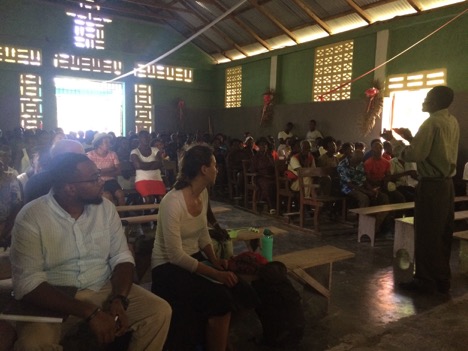 |
| The Pastor addresses the crowd at Morency. |
About 150 people showed up to the community meeting which packed the church with standing room only. Sandra, being translated by Patrick when on to ask further questions of the community. By a quick survey about 30 people were under the age of 25, 75 were between the ages of 26-50, and 45 were over the age of 50. 50 of those who attended were the heads of the household. Four people had experience working with electricity. And about 15 people in the crowd said they could come up with the 1000 gourdes to buy a system.
Sandra and Patrick asked the crowd what their education level was. When there wasn’t much of a response Patrick then asked about literacy and about 90 people in the crowd said they could read and write. When asked about their biggest concerns they responded with health, roads, and energy in that order. The leader then tried to retract that statement and said if the community had a stronger economy and access to jobs that would solve all the problems the crowd had stated.
When asked about a sol and whether or not the crowd knew about it they all responded warmly. They all thought that it was a good method to get the product. A sol is when a certain group let’s say 7 people, all buy in to get a product they all put in like x amount per week and the first person on the list buys the product when the money is saved up. Then it starts again till the second person on the list can get one and so on and so forth. The crowd was concerned about who would be an agent, they wanted someone who was serious about the job but at the same time sociable.
The floor was then for the community to ask questions about the product.
Jacques a plumber with 4 people living with him said a lot of people want this system. His concern was that most of this village relies on fishing. Sometimes they can go three to four months without a good catch to sell and won’t have the money to pay for Energy24 all the way through if it is a 1-2 year program to pay off the system.
A man by the name Stanley reiterated Jacques’ point, he said no fish no economy in the village. He said some people will buy the system but not everyone will be able to afford it.
Until that point, only men had asked questions. Sandra asked if any women had questions, Patrick translated.
Jillian with 4 people in her house was wondering who would be collecting the payments.
Respondent #1, wanted to know who to call and where to go if the product were to malfunction. He said that the target customers will most likely be those that operate the churches or the ones that sail boats to fish.
Respondent #2, had 4 people at his house. He was confused at exactly what capacity 10Power and DigitalKap were there for. Patrick had to draw the line between what a nonprofit like Hope for Haiti is and what a for-profit like the Energy24 initiative is. While it is socially conscious it is still a for-profit enterprise.
Belfort, a male teacher with 7 people living with him, reiterated the harsh economy and wanted to see if they had lower prices than 25 gourdes a day for the Energy24 pay as you go program.
Respondent #3, had 3 people at their house and wanted to know if that system would last long, specifically the battery which Patrick went on to explain the benefit of having a gel battery in the system.
The meeting was adjourned and the community was able to sign up to be agents for managing the project in the village or sign up for the product itself. Everyone of age was interested in one or the other.
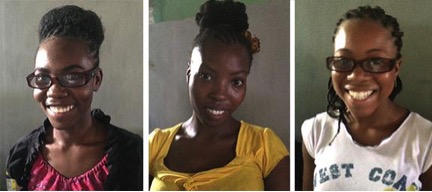
Young women from Morency who signed up to become solar agents for their community.
Anse-a-Veau
We made the next stop the following day. Similar to Morency, getting to the village in Anse-A-Veau was harder than previously thought. Halfway up we had to stop the minibus and take motorcycles to the village. One of the DigitalKap employees, Menel is from the area and wanted to see if this community could benefit from the program. Again we had to arrange a meeting inside the church with the church elder. We came later than planned partly due to the transportation issues and many people left the church after waiting for a while. We tried to make it in time for the celebration the village had at the church for St. Laurent. For the launch we ended up taking the smaller units with radio for the demonstration because of the motorbike transportation.
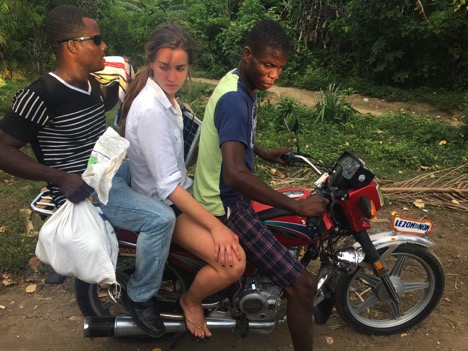
DigitalKap team member Menel and 10Power team member Hannah transport solar equipment on a motorbike to Anse A Veau.
Menel introduced us and made it a point that Energy24 was a great product that the village could benefit from. Patrick then introduced the product and began asking the crowd about their energy needs. The majority of the crowd needed to use oil or gas for power. Many of the people in the crowd paid about 10 gourdes to power their cell phones, which usually took a whole day to charge at a station away from their home. A few people in the crowd wanted to be sure the pay as you go system actually worked. Some people wanted to make it understood that they’re a poor community and buying a system outright is not possible for majority of the community. On the other hand, some people pay up to 16 Haitian dollars = 80 Haitian gourdes for a gallon of gas/crude oil.
Sandra started again with the 10Power call and it was warmly received by the crowd. When the crowd was asked if they want electricity they all said yes and thought it was comical that the question was even asked. She went on to survey the community along with translations by Patrick. About 50 people attended the meeting. Of those attendees 20 people were age 25 and under, 24 people were between ages 26 and 50, and 6 people were over the age of 50. About 12-15 people were the head of the household. And one person had experience working with electricity. The floor was then opened up for questions by the audience.
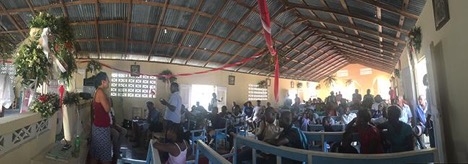
Sandra addresses the crowd at Anse A Veau.
Respondent # 1 had 7 people living in the household, about 14 cellphones. Currently pays close to 3 Haitian dollars (15 gourdes) for electricity to charge phones. Wanted electricity for radio, TV, and to be able to power things in his home and not have his children have to leave the house so often just to find power. He wants to save money on the different energy expenses for his children. Also wanted to know if there are bigger systems because we were not able to show the larger system due to transportation issues. He was not able to do the math to calculate how much he would have to pay over a 2-year span on 25 gourdes a day. Patrick calculated it for him and once he saw the number between what he is paying now for energy and what he would with Energy24 he was on board to buy a system outright once he had the money. 10Power team member Nicholas Weidinger mentioned we should have infographics showing how much you pay now for crude oil/gas/charge cell phones over two years and Energy24 over 2 years. Visuals would definitely help for communities that are lacking education.
Respondent #2 had 6 people living in the household. Spends too much money on gas and oil for energy. With Energy24 he’d be able to charge his phone and use a radio.
Respondent #3 wondered if it can charge well with little sun and if in time of a catastrophe it can be reliable. Also expressed that the people did not want to be exploited. François (DigitalKap) had to then explain that DigitalKap and 10Power were two different entities. Though 10Power is based in the US DigitalKap which has ownership of Energy24 is Haitian owned and based in Haiti.
Respondent #4 commented that he didn’t like how the product is not manufactured in Haiti.
There was overwhelming interest from people who wanted to become solar agents, but it was very difficult to sign up women in Anse A Veau. Sandra approached several women and they declined. Finally she recruited one woman agent.
The trip to Haiti gave much insight into the possibilities of solar power in Haiti. Energy24 is a promising project and 10Power will continue its work to build a sustainable and resilient Haiti one solar panel at a time. The 10Power team is incredibly greatful to Invoking the Pause for funding this opportunity.
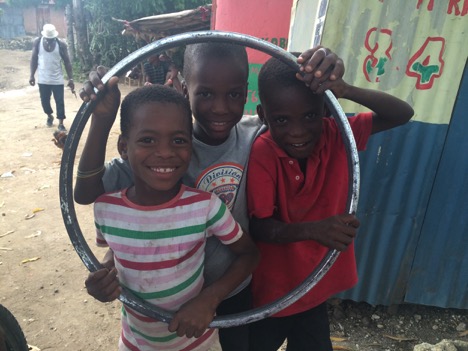
Children from Anse A Veau.
Categories
- All
- #ZeroBy2050
- 10Power
- 350 Seattle
- 36.5
- ANHE
- ARC-KE:i
- Al Gore
- Alicia Escott
- American Resilience Project
- Anjali Nayar
- Anthony Myint
- As You Sow
- At the Water's Edge
- Bard Center for Environmental Policy
- Beka Economopoulos
- Biomimicry Collaborative
- Bioneers
- Black Permaculture Network
- Blossoming Possibilities
- Blue Heart Labs
- Bodhi Garrett
- Britta Riley
- Bureau of Linguistical Reality
- C2C(Change 2 Climate)
- CELI
- COP21
- COP22
- California Foodways
- California Institute for Rural Studies
- Carbon Shock
- Casey Beck
- Catalogue of Extinct Experience
- Cathedral of St. John the Divine
- Center for Investigative Reporting
- Change the Bulb
- Chris Desser
- CityLab7
- Clean Energy Leadership Institute
- Climate Change
- Climate Science Alliance
- Climate Solutions Group
- CoClimate
- Convening 2010
- Coronavirus
- Council of Pronghorn
- Daily Acts
- Dancing Earth
- Dancing Without Borders
- Dr. Renee Lertzman
- Dream Rider Productions
- DreamRider Productions
- Duke University
- E2
- Earth Guardians
- Earthseed Consulting
- Eban Goodstein
- Eve Mosher
- Faith Kearns
- GAIA
- Gary Nabhan
- General
- Global Climate Action Summit
- Grant Partner Gathering
- Grant Partner Spotlight
- Grant Partners
- Grant Proposal Application
- Grants
- Happening
- Heidi Quante
- HighWaterLine
- Human Impacts Institute
- Impact Experience
- Impact Hours
- Invoking the Pause
- Joshua Fouts
- KALW
- KQED
- Kelly McVicker
- Kiss The Ground
- Libby Modern
- Lien Tran
- Lindley Mease
- Lisa Micheli
- Lisa Morehouse
- Magalie Bonneau
- Maggie Kaplan
- Mark Hertsgaard
- Mark Schapiro
- McDonalds
- Monica Wilson
- Morgan Curtis
- Natural History Museum
- Newsweek
- Nicole Heller
- Nicole Lederer
- Nina Simons
- Nina Wise
- Optimist Daily
- Pandora Thomas
- Paris COP21
- Pepperwood Preserve
- Peter Cunningham
- Planet Protector Academy
- Planet Protectors
- Post Pause
- Power Shift Network
- Presidio Graduate School
- Psych Alive
- Rainforest Connection
- Rebecca Patton
- Reinhard Hohlwein
- Rulan Tangen
- SPM3
- Sandra Kwak
- Sarah Cameron Sunde
- Science House Foundation
- Seeding Possibilities
- Seeds of Resistance
- Starbucks
- Stephen Antupit
- Sun Valley Forum
- SustainUS
- TIMBY
- Taco Diplomacy
- Tara DePorte
- Tensorflow
- Terry Tempest Williams
- The Arctic Cycle
- The Natural History Museum
- The Optimist Daily
- The Organic Life
- The Perennial
- The Redford Center
- Topher White
- Transition US
- Trathen Heckman
- Tribal Changes App
- University of Miami
- Videos
- Village Green(er)
- Wildlife Conservation Network
- Windowfarms
- Winters Past
- Works on Water
- World Business Academy
- XSproject
- Xi Martinez
- Zero Foodprint
- invoking the Pause

